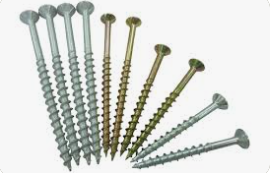Introduction to Tapping Screws
Tapping screws are a fundamental component in various construction, manufacturing, and DIY projects. These versatile fasteners play a pivotal role in securely joining materials, making them an essential part of our daily lives. In this article, we will explore the world of tapping screw, from their types and applications to installation techniques and maintenance.
What Are Tapping Screws?
Tapping screws, also known as self-tapping screws, are threaded fasteners designed to create their threads as they are driven into a pre-drilled hole or material. Unlike traditional screws that rely on a pre-existing thread, tapping screws form their threads, providing a strong and secure connection.
Types of Tapping Screws
There are two main types of tapping screws:
Thread-Forming Tapping Screws
Thread-forming tapping screws, as the name suggests, create threads by deforming the material as they are inserted. These screws are ideal for softer materials like plastics, aluminum, and sheet metal.
Thread-Cutting Tapping Screws
Thread-cutting tapping screws have sharp cutting edges that remove material as they are driven in, forming threads. They are suitable for harder materials like steel and hardwood.
Common Applications of Tapping Screws
Tapping screws are widely used in a variety of applications, including construction, automotive, electronics, and furniture assembly. They are particularly valuable when a strong and reliable fastening solution is required.
Advantages of Using Tapping Screws
- Exceptional fastening strength
- Self-drilling capability
- Reduced need for pilot holes
- Efficient and quick installation
- Wide material compatibility
Factors to Consider When Choosing Tapping Screws
Selecting the right tapping screws is crucial for a successful project. Consider the following factors:
Material of the Screws
The material of the screws should match the material you are fastening. For instance, stainless steel tapping screws are suitable for outdoor applications due to their corrosion resistance.
Size and Length
Choose the appropriate size and length of tapping screws to ensure a secure fit.
Drive Type
Tapping screws come with various drive types, such as Phillips, Torx, or square drives. Select the one that suits your needs and tools.
How to Install Tapping Screws
Proper installation is essential for the effectiveness of tapping screws. Follow these steps:
Pre-Drilling
Always pre-drill a hole slightly smaller than the screw’s diameter to prevent splitting or cracking of the material.
Correct Torque
Use the correct amount of torque to prevent overtightening or stripping the threads.
Maintenance and Care for Tapping Screws
Maintain your tapping screws by inspecting them periodically for corrosion or wear. Replace any damaged or worn screws promptly to maintain the integrity of your project.
Comparing Tapping Screws to Other Fasteners
Tapping screws offer distinct advantages over other fasteners, such as nails or traditional screws. They provide a more secure and long-lasting connection, making them a preferred choice in many applications.
Troubleshooting Common Issues
Tapping screws may encounter some common issues:
Stripped Threads
If the threads become stripped, it’s usually due to over-tightening. To resolve this, consider using a larger screw or tapping a larger hole.
Corrosion
In outdoor applications, corrosion can be a concern. Choose corrosion-resistant screws or apply a protective coating to mitigate this issue.
Innovations in Tapping Screw Technology
Advancements in materials and design have led to innovations in tapping screw technology, resulting in improved performance, durability, and ease of use.
Environmental Impact of Tapping Screws
The environmental impact of tapping screws is relatively low compared to other fasteners. Their longevity and reusability make them a sustainable choice for many projects.
Conclusion
Tapping screws are an indispensable tool in the world of fasteners, offering reliability and strength in a variety of applications. By understanding their types, applications, and proper usage, you can ensure successful projects and long-lasting connections.
Frequently Asked Questions (FAQs)
What are the advantages of using tapping screws?
Tapping screws offer exceptional fastening strength, self-drilling capability, and efficient installation. They are ideal for a wide range of materials and applications.
How do I choose the right tapping screw size?
Select the appropriate size by considering the material and thickness of the materials being joined. Ensure the screw is long enough to provide a secure fit.
Can tapping screws be used in outdoor applications?
Yes, tapping screws can be used outdoors, especially if they are made from materials like stainless steel that are resistant to corrosion.
What is the difference between thread-forming and thread-cutting tapping screws?
Thread-forming tapping screws create threads by deforming the material, while thread-cutting tapping screws cut threads as they are driven in. The choice depends on the material you are working with.
Are tapping screws environmentally friendly?
Tapping screws have a relatively low environmental impact due to their reusability and long lifespan. They are considered a sustainable fastening solution.





